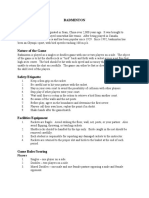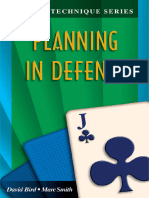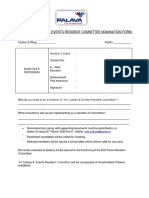0 ratings0% found this document useful (0 votes)
50 viewsQ Agreement Q Stalemate Q Triple Occurrence of Position Q Insufficient Material Q "50 Move" Rule
This document summarizes the six ways a chess game can end in a draw: 1) Agreement between players, 2) Stalemate, 3) Triple occurrence of the same position on the board, 4) Insufficient material to checkmate, 5) 50 move rule with no capture or pawn move in the last 50 moves, and 6) tournament procedures for claiming draws. Tactics are discussed for both losing and winning players to potentially engineer draws in difficult situations. Players are advised to only accept draws if it benefits their position.
Uploaded by
Keyur GadaCopyright
© © All Rights Reserved
Available Formats
Download as PDF, TXT or read online on Scribd
0 ratings0% found this document useful (0 votes)
50 viewsQ Agreement Q Stalemate Q Triple Occurrence of Position Q Insufficient Material Q "50 Move" Rule
This document summarizes the six ways a chess game can end in a draw: 1) Agreement between players, 2) Stalemate, 3) Triple occurrence of the same position on the board, 4) Insufficient material to checkmate, 5) 50 move rule with no capture or pawn move in the last 50 moves, and 6) tournament procedures for claiming draws. Tactics are discussed for both losing and winning players to potentially engineer draws in difficult situations. Players are advised to only accept draws if it benefits their position.
Uploaded by
Keyur GadaCopyright
© © All Rights Reserved
Available Formats
Download as PDF, TXT or read online on Scribd
You are on page 1/ 1
Tournaments and Tactics
The
Draw A PieceTakers Mini-lesson Level: Intermediate
When a chess game ends in a tie, it is known as a “draw” and is worth half a win.
1) 5 ways a game can end in a draw 2) Draw by Agreement
q Agreement One player offers a draw to their opponent. The
opponent may accept or reject.
q Stalemate
q Triple occurrence of position Tournament play: According to the USCF rule
book, the proper sequence for offering a draw is:
q Insufficient material
q “50 move” rule 1) Make your move
2) Offer draw
3) Draw by Stalemate 3) Punch clock
4) While their clock is running, opponent may
accept or reject. If they touch a piece, the offer is
One player cannot make a legal move but is not in
considered rejected. If their clock runs out while
check.
considering, you win.
Tactics:
Tactics: Some players, fearing a impending
n Losing big? Try to engineer a stalemate for half loss, will try to persuade their inexperienced
a win. opponent to accept a draw.
n Winning big? Watch out for that stalemate that
may rob you of a win! Accept a draw only if it is to your advantage.
4) Draw by Triple occurrence of 5) Draw by Insufficient material
position A player correctly claims a win is impossible
because of pieces left on board. Insufficient
A player correctly claims the position of all pieces material claims include:
on the board has occurred 3 times in the game.
q King Vs King
Tournament play: The claiming player must q King Vs King + bishop
show proof to the judge either through careful q King Vs King + knight
notation or demonstration.
Tactics: Running low on time? A sequence o f
Tactics: Losing? Try to engineer a repetitive trades may force a draw based on insufficient
check that can get a draw due to this rule. material.
6) Draw by 50 move rule V1.3
A player claims a draw because the last 50 moves have not resulted in a capture or pawn move.
Copy -
Tournament play: The claiming player must show proof to the judge either through notation right
1998
or demonstration.
cr
Tactics: If you plan to make this claim, let the judge know. Many judges will not be willing to beach
stand by counting the moves but may validate the claim based on observed play. Notation is
your best bet for a successful claim.
You might also like
- Hourglass Workout Program by Luisagiuliet 276% (21)Hourglass Workout Program by Luisagiuliet 251 pages
- The Hold Me Tight Workbook - Dr. Sue Johnson100% (16)The Hold Me Tight Workbook - Dr. Sue Johnson187 pages
- Read People Like A Book by Patrick King-Edited62% (65)Read People Like A Book by Patrick King-Edited12 pages
- Livingood, Blake - Livingood Daily Your 21-Day Guide To Experience Real Health77% (13)Livingood, Blake - Livingood Daily Your 21-Day Guide To Experience Real Health260 pages
- COSMIC CONSCIOUSNESS OF HUMANITY - PROBLEMS OF NEW COSMOGONY (V.P.Kaznacheev,. Л. V. Trofimov.)94% (212)COSMIC CONSCIOUSNESS OF HUMANITY - PROBLEMS OF NEW COSMOGONY (V.P.Kaznacheev,. Л. V. Trofimov.)212 pages
- Donald Trump & Jeffrey Epstein Rape Lawsuit and Affidavits83% (1016)Donald Trump & Jeffrey Epstein Rape Lawsuit and Affidavits13 pages
- The 36 Questions That Lead To Love - The New York Times94% (34)The 36 Questions That Lead To Love - The New York Times3 pages
- The 36 Questions That Lead To Love - The New York Times95% (21)The 36 Questions That Lead To Love - The New York Times3 pages
- Jeffrey Epstein39s Little Black Book Unredacted PDF75% (12)Jeffrey Epstein39s Little Black Book Unredacted PDF95 pages
- The 4 Hour Workweek, Expanded and Updated by Timothy Ferriss - Excerpt23% (954)The 4 Hour Workweek, Expanded and Updated by Timothy Ferriss - Excerpt38 pages
- Module 4 - Badminton - History, Basic Skills, Equipment, Rules and RegulationsNo ratings yetModule 4 - Badminton - History, Basic Skills, Equipment, Rules and Regulations39 pages
- Badminton: Group 2 2019/09/19 Members: Gajano, Salandanan, Esteban, Paltingca, Lo, Putis, GenerosoNo ratings yetBadminton: Group 2 2019/09/19 Members: Gajano, Salandanan, Esteban, Paltingca, Lo, Putis, Generoso35 pages
- The AFC Combat League: Rules For CompetitionNo ratings yetThe AFC Combat League: Rules For Competition4 pages
- Preparation Exam For Chess Supervisors ContentsNo ratings yetPreparation Exam For Chess Supervisors Contents4 pages
- Module 1.1-Badminton (Rules and Basic Skills)No ratings yetModule 1.1-Badminton (Rules and Basic Skills)6 pages
- Shuttle And: Is The Caught On The Net The of The A ANo ratings yetShuttle And: Is The Caught On The Net The of The A A18 pages
- ABC Unified Rules of Professional Kickboxing (1)No ratings yetABC Unified Rules of Professional Kickboxing (1)5 pages
- Adepticon 2024 Bolt Action Combat PatrolNo ratings yetAdepticon 2024 Bolt Action Combat Patrol10 pages
- Planet PC DotA Tournament Official RulesNo ratings yetPlanet PC DotA Tournament Official Rules9 pages
- Hand Evaluation Methods - Part 1 - Rev 2No ratings yetHand Evaluation Methods - Part 1 - Rev 26 pages
- Sports Taekwondo: Stances Hand Attacks. Kicks Blocks PatternsNo ratings yetSports Taekwondo: Stances Hand Attacks. Kicks Blocks Patterns5 pages
- Art, Culture & Events Resident Committee Nomination Form.: Will Be Composed of 5 Nominated Palava ResidentsNo ratings yetArt, Culture & Events Resident Committee Nomination Form.: Will Be Composed of 5 Nominated Palava Residents2 pages
- Enjoy A Naturally Rejuvenating Alternative To Treat Yourself With Himalayan Wellness Products!No ratings yetEnjoy A Naturally Rejuvenating Alternative To Treat Yourself With Himalayan Wellness Products!6 pages
- J.H. Blake - Chess Endings For Beginners 7th Ed0% (1)J.H. Blake - Chess Endings For Beginners 7th Ed1 page
- Dizi Fingering Chart 7 Hole Printable PDFNo ratings yetDizi Fingering Chart 7 Hole Printable PDF1 page
- Analysis of The Game of Chess 1790 - Philidor PDF100% (1)Analysis of The Game of Chess 1790 - Philidor PDF418 pages
- CompradoCeci Book Pawns, Time and Space in Modern Chess - Dragan BarlovNo ratings yetCompradoCeci Book Pawns, Time and Space in Modern Chess - Dragan Barlov1 page
- Jerry Token Farm - A Blockchain Based Decentralized Finance ApplicationNo ratings yetJerry Token Farm - A Blockchain Based Decentralized Finance Application3 pages
- Chess on the Edge Volume 1 Bruce Harper 2024 Scribd Download100% (3)Chess on the Edge Volume 1 Bruce Harper 2024 Scribd Download81 pages























































































































